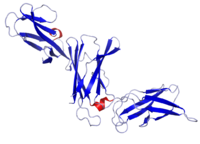
Photo from wikipedia
Interleukin-6 (IL-6) is a pleiotropic cytokine that activates a classic signalling pathway upon binding to its membrane-bound receptor (IL-6R). Alternatively, IL-6 may 'trans-signal' in a manner that is facilitated by… Click to show full abstract
Interleukin-6 (IL-6) is a pleiotropic cytokine that activates a classic signalling pathway upon binding to its membrane-bound receptor (IL-6R). Alternatively, IL-6 may 'trans-signal' in a manner that is facilitated by its binding to a soluble derivative of the IL-6 receptor (sIL-6R). Resultant signal transduction is, respectively, driven by the association of IL-6/IL-6R or IL-6/sIL-6R complex with the membrane-associated signal transducer, gp130 (Glycoprotein 130). Distinct JAK (Janus tyrosine kinase)/STAT (signal transducers and activators of transcription) and other signalling pathways are activated as a consequence. Of translational relevance, overexpression of IL-6 has been documented in several neoplastic disorders, including but not limited to colorectal, ovarian and breast cancer and several haematological malignancies. This review attempts to summarise our current understanding of the role of IL-6 in cancer development. In short, these studies have shown important roles for IL-6 signalling in tumour cell growth and survival, angiogenesis, immunomodulation of the tumour microenvironment, stromal cell activation, and ultimate disease progression. Given this background, we also consider the potential for therapeutic targeting of this system in cancer.
Journal Title: Biochemical Society transactions
Year Published: 2018
Link to full text (if available)
Share on Social Media: Sign Up to like & get
recommendations!